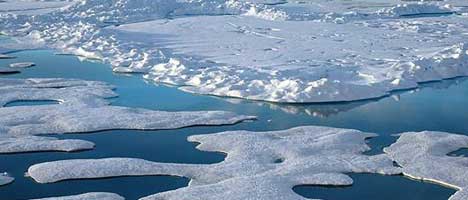Arctic Sea Ice Trends and Extremes

Contacts, for more information:
Arctic sea ice cover has declined sharply over the past three decades according to satellite observations. This change has many impacts on Arctic ecosystems and human operations in the Arctic Ocean. Climate models also show a decline, but have difficulty accounting for the magnitude of the observed changes. The same anthropogenic forcings that are involved in global warming are implicated, but natural variability may also play a role. Distinguishing these factors is important for predicting the future of the Arctic ice because anthropogenic warming is expected to continue increasing, further diminishing the ice cover, but natural variability influences will not persist.
GFDL Research
Sorting out the relative roles of natural variability and anthropogenic forcing on the ice decline is a major area of GFDL research. Our findings show that the Atlantic overturning circulation factors into both the forced decline and variability of the Arctic sea ice. By comparing model-simulated ice declines in models with large and small weakenings of the overturning, the connection to the expected 21st century decline in this circulation was established — a larger weakening of the overturning helps to maintain the sea ice cover. However, a statistical analysis of the simulated natural variations in the overturning and sea ice cover also showed a connection.
A recent study using a GFDL climate model identified three key factors (Atlantic/Pacific ocean heat transport into the Arctic, and the atmospheric Arctic Dipole) as being important for multi-year variability of summer Arctic sea ice extent. The study concluded that changes in these key factors could have contributed substantially to the observed decline in the sea ice extent in recent decades.
Another useful way to look at the observed ice decline is to divide it by the global temperature change. We have used this method to show that the observed ice decline per degree global warming requires natural variability as part of the explanation if the climate models are correctly simulating anthropogenically forced changes. This technique can also be applied to extreme events. We showed that the record-breaking low sea ice cover in September 2012 could not be explained by natural variability alone according to the models, indicating a role for anthropogenic forcing in extreme sea ice events as well as in the long-term decline.



